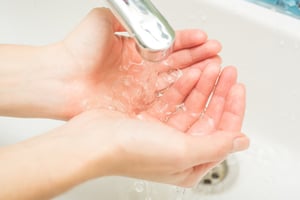WOULD YOU RATHER HAVE 100% COMPLIANCE THROUGH MANUAL OBSERVATION OR 80% COMPLIANCE WITH OBJECTIVE DATA?
 If the “law of diminishing returns” applies to hand hygiene: is achieving 100% compliance always worth the cost? Or, is there a point at which the benefits are less than the amount of time or money invested in increasing compliance?
If the “law of diminishing returns” applies to hand hygiene: is achieving 100% compliance always worth the cost? Or, is there a point at which the benefits are less than the amount of time or money invested in increasing compliance?
JCAHO released their Requirement for Improvement on January 1, 2018 and really upped the ante for healthcare organizations to focus on their staff’s education and execution of hand-hygiene. Study after study cites the correlation between an increase in hygiene compliance and a reduction in hospital-acquired conditions.
Unlike Electronic Health Records though, hygiene compliance is not a disruption to staff workflow. Hygiene compliance is a fundamental tenet of the Hypocritic Oath and in theory, should put more flexibility back into the hands of healthcare workers through reduced complications, lengths of stay, etc.
So, how do healthcare organizations strike the delicate balance between being a fair and just culture when dealing with hygiene compliance rates?
Is 100% compliance achievable?
It’s very difficult to trust the 95% +/- compliance data that your secret-shopper program produces today especially if you are currently on the Medicare HAC penalty. Healthcare workers by nature are extremely competitive individuals and the lion’s share have positive intent when they go to work every day. If one of your patients suddenly goes into cardiac-arrest though, is hygiene compliance going to be the first thing on a healthcare worker’s mind? If your hospital is licensed for 350 beds but your highest daily census is 250 and you stock supplies in a vacant room, what is your protocol for hygiene compliance in that vacant room?
Edge cases are the biggest driver for creating a fair and just safety culture. Objective data can be used to influence people to change their behaviors and comply with evidence-based care guidelines. Hygiene monitoring systems are complementary to creating that culture of accountability. However, leadership must recognize the importance of not letting perfect be the enemy of good. Today’s compliance is bad, with the help of technology it can at least be good.
100% compliance and the impact on patient care
In instances of dealing with a particularly virulent pathogen, there is some merit to continuing to strive for 100% compliance. However, if rates are at 80%, increasing them to 90% seems to be less effective.
However, there are other goals that we can achieve at 80% compliance rather than striving for 100%. These include:
- Decreased Hospital Acquired Infections
- Decreased length of stay
- Bed availability
- Equipment availability
- Reduction in testing and procedures
What makes the most sense? The “law of diminishing returns” does exist in hygiene compliance!
With that, 80% compliance is the gold standard that we strive for with 24/7/365 objective compliance data and there are many organizations striving for that goal with us.
At the end of the day, we have to start somewhere on the path to reducing the almost $10 Billion impact of just the top 5 HAIs on the US Healthcare system annually. Hygiene compliance is a no-brainer so let’s be good, for now!


